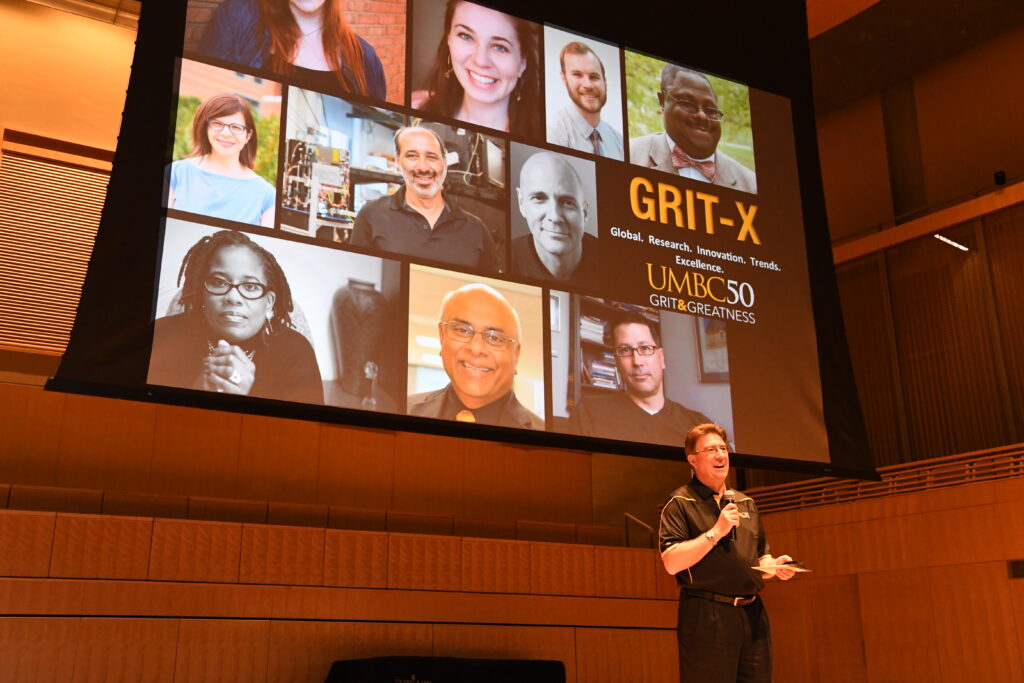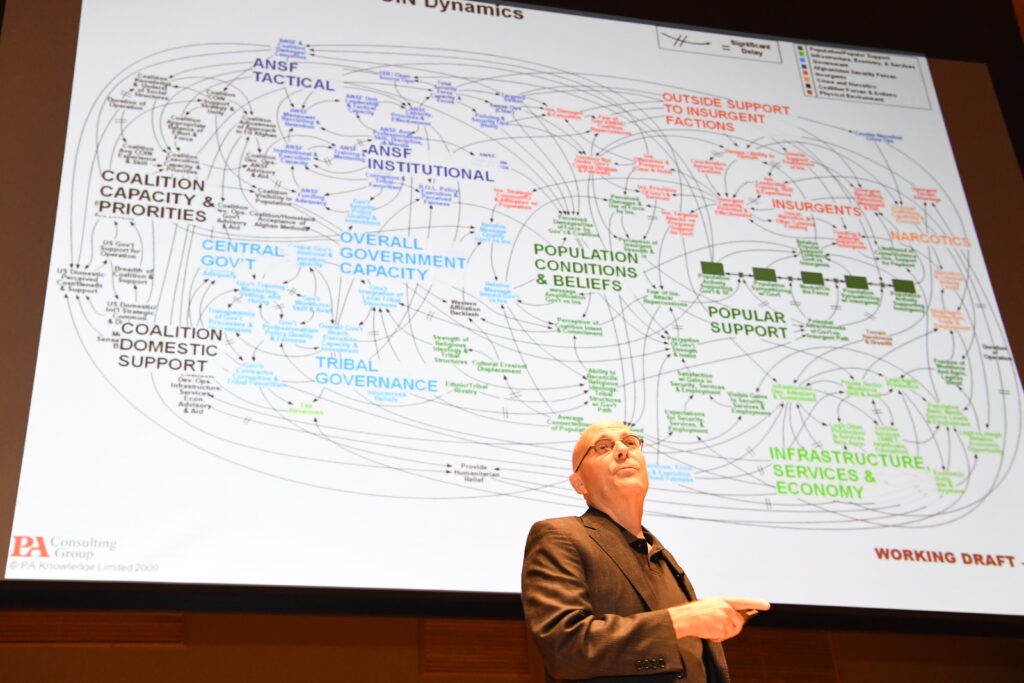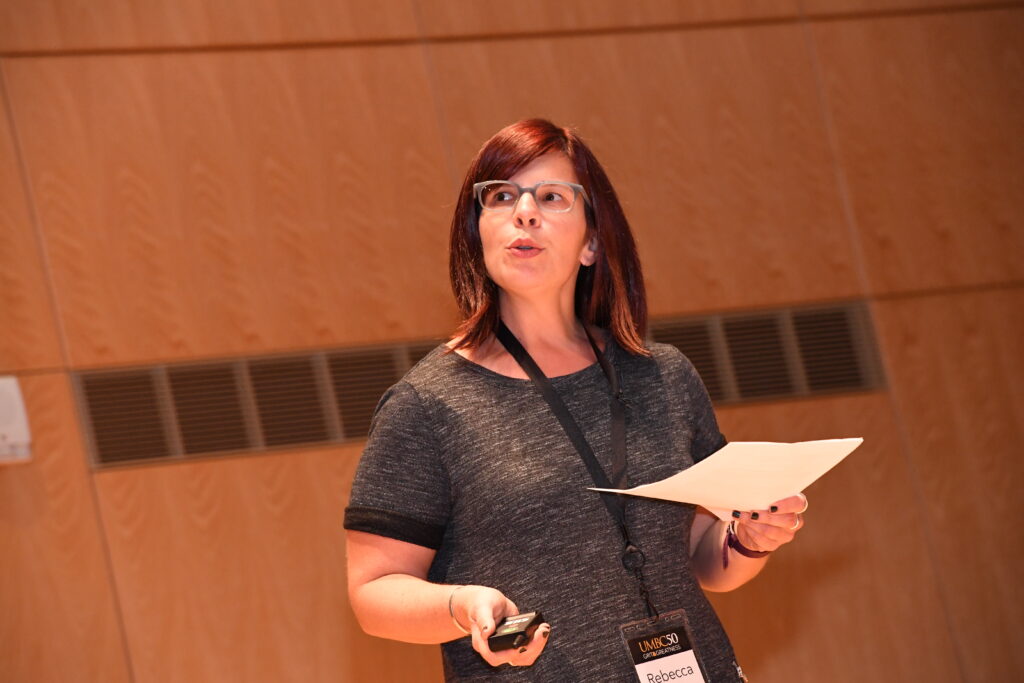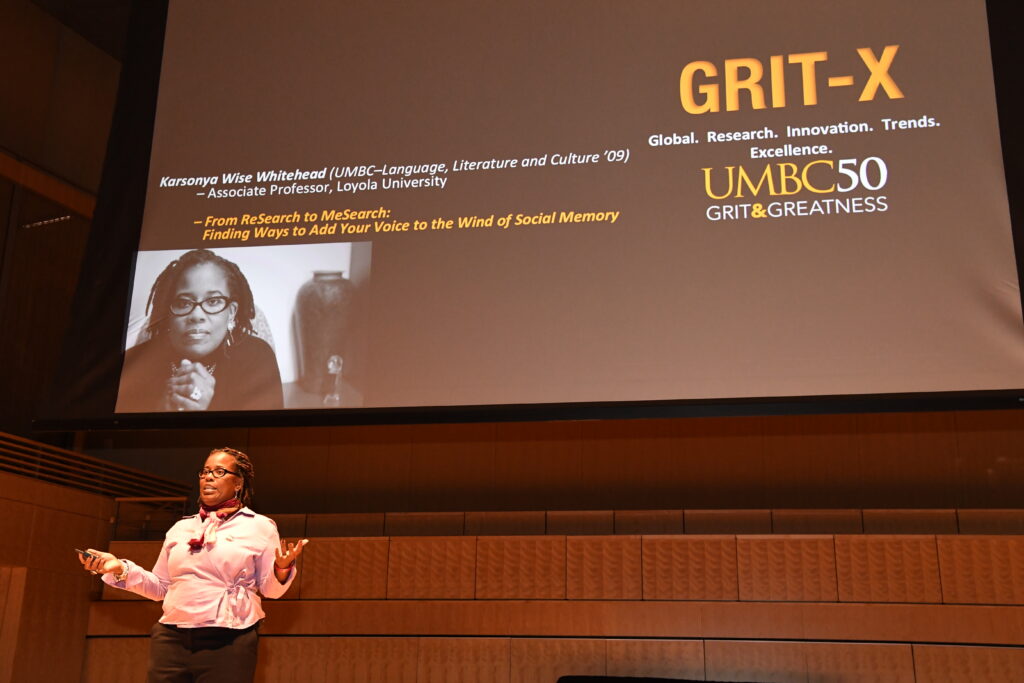Some of UMBC’s most fascinating research and achievements were shared through an exciting “GRIT-X’ format during the university’s 50th anniversary celebration on September 17, 2016. Faculty and alumni from across disciplines presented a series of engaging talks before an enthusiastic audience in Earl and Darielle Linehan Concert Hall.
Planning for the GRIT-X event started almost a year before the 50th celebration. Hosted by Karl Steiner, vice president for research, the event featured three sets of 10-minute talks that covered topics from the process for creating a successful theatre company to dealing with contaminants of emerging concern in local watersheds.
 Karl Steiner opens GRIT-X at UMBC.
Karl Steiner opens GRIT-X at UMBC.“We really wanted to put a program together that…gives a glimpse at the diversity of programs and groundbreaking, impactful research and the many thought-provoking topics that many of our alumni and faculty are working on,” explained Steiner at the beginning of GRIT-X.
Several talks centered around what faculty and alumni are doing locally in and around Baltimore.
Kiirstin Pagan ’11, theatre, and Katie Hileman ’12, acting, shared how a dream that started when they were undergraduates at UMBC has led to the creation of the award-winning Interrobang Theatre Company, which is set to produce its seventh show later this year. Pagan and Hileman explained how they started their business and why they chose to remain in Baltimore after graduating.
“We love Baltimore,” shared Hileman. “We see it as a place of potential and growth, and it’s a place where artists are doing their work because they feel passionate about it…it’s also a place that’s really receptive to new and interesting work.”
Focusing on environmental impacts, Lee Blaney, an assistant professor of chemical, biochemical, and environmental engineering, explained how waste from contaminants such as antibiotics and fragrances that we use on a regular basis are impacting Baltimore streams.
Lee Boot, director of the Imaging Research Center (IRC), described how visual knowledge and information can reflect and influence how people think about the world. He described a current IRC project titled “The Art of Transformation,” where UMBC students, faculty, and staff are working with community organizations and residents in Baltimore to try to develop culture-based solutions and approaches to community development.
 Lee Boot presents “A Grand Visualization Challenge” at GRIT-X.
Lee Boot presents “A Grand Visualization Challenge” at GRIT-X.“This entire enterprise where university people and community people are working hand-in-hand is a collaborative effort without a real hierarchy,” said Boot.
Many presentations focused on public policy, civic engagement, and social issues. Tyson King-Meadows, associate dean of the College of Arts, Humanities, and Social Sciences, discussed how voters react frequently to what they hear and see and insulate themselves from information that they don’t agree with, resulting in what King-Meadows cautions is a less empowered citizenry.
Drawing on her book Beyond the Checkpoint – Visual Practices in America’s Global War on Terror (University of Massachusetts Press 2014), Rebecca Adelman, associate professor of media and communication studies, shared how an experience she had at an airport security checkpoint helped sparked a research project where she investigated American visual culture of the Global War on Terror and its impact on society.
 Rebecca Adelman presents at GRIT-X.
Rebecca Adelman presents at GRIT-X.Thomas Schaller, professor and chair of political science, examined the decline in civics education in high schools and how it should influence teaching college students about politics and their significance in such a polarized and partisan climate.
Karsonya Wise Whitehead ’09 Ph.D., language, literacy, and culture, reflected on the letters that she has written to her two sons as they have grown. She emphasized how the power of the written word can be a teaching tool and window into navigating parenthood.
 Karsonya Wise Whitehead ’09 Ph.D., language literacy and culture, presents at GRIT-X.
Karsonya Wise Whitehead ’09 Ph.D., language literacy and culture, presents at GRIT-X.“When people read letters to my black sons and they see my love for my sons poured out onto the page, it is a different experience. It’s a different way of connecting. It’s a way of taking the research off of the page and putting it into your lives,” said Whitehead.
UMBC’s efforts to research how man-made pollution is influencing Earth’s energy balance and precipitation were highlighted in a talk by Vanderlei Martins, a professor of physics.
In a presentation about “disruptive innovation,” Govind Rao, professor of chemical, biochemical, and environmental engineering, talked about transformative UMBC inventions that have the potential to save millions of lives, such as the the development of a cardboard incubator and manufacturing complex medicines from a suitcase-size device.
“I’m hoping that we continue to make positive change for the rest of the world,” said Rao.
Read more about UMBC’s 50th anniversary weekend.
Photos: Header image: Vanderlei Martins. All images by Jim Burger. GRIT-X at UMBC, September 17, 2016.





